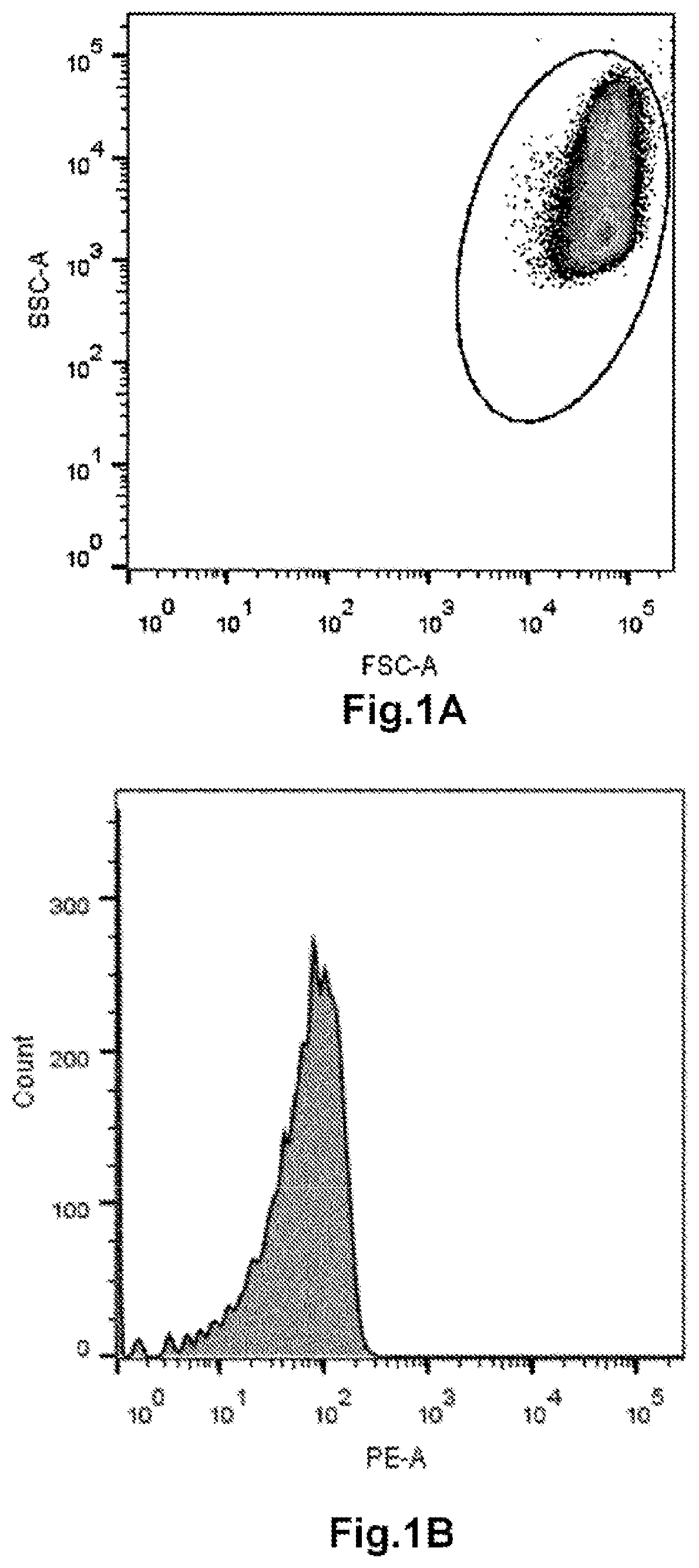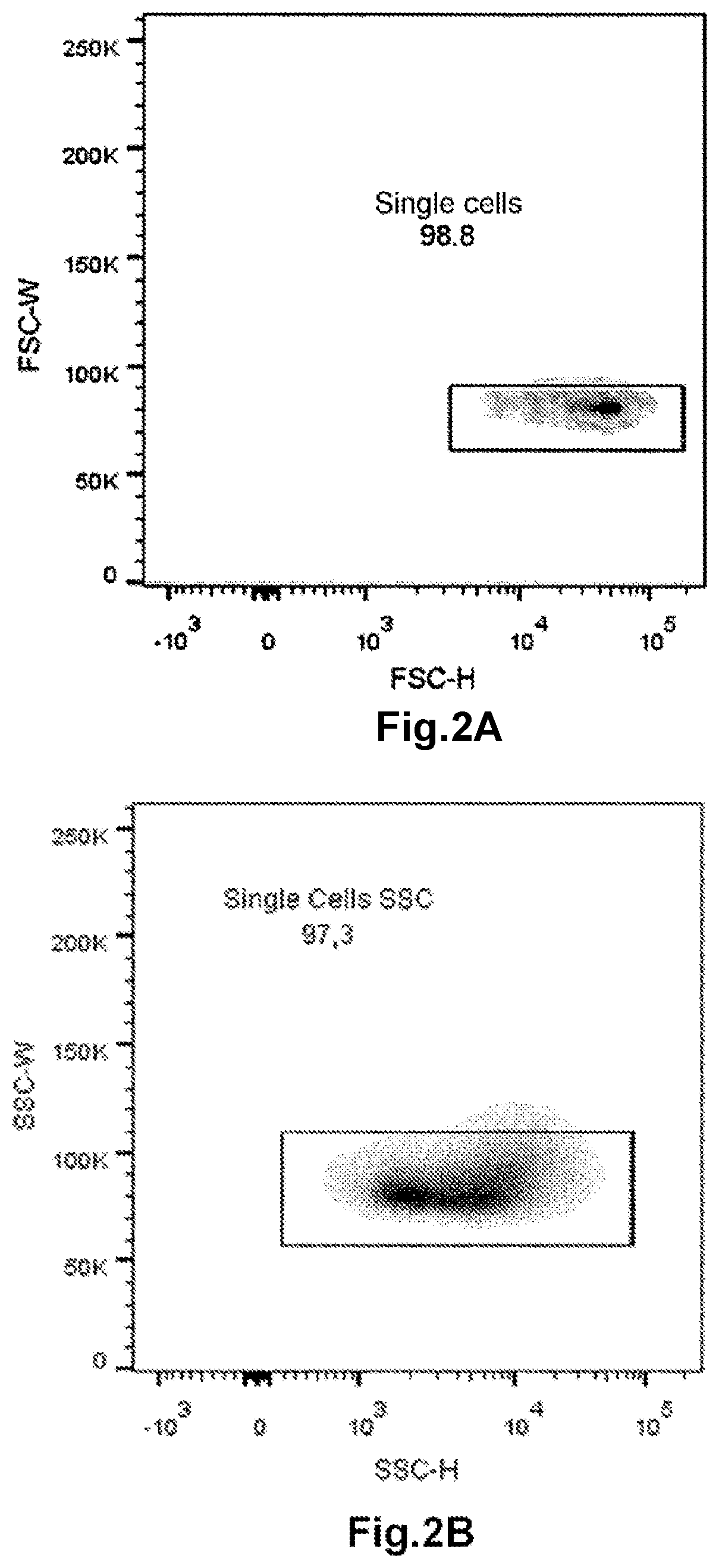Method for determining the haemoglobin F content of an erythroid cell
a technology of erythroid cells and haemoglobin, which is applied in the direction of fluorescence/phosphorescence, instruments, material analysis, etc., can solve the problems of increasing the incidence of children's mortality in developing countries, increasing the mean hbf content, and not being sensitive to methods
- Summary
- Abstract
- Description
- Claims
- Application Information
AI Technical Summary
Benefits of technology
Problems solved by technology
Method used
Image
Examples
example 1
nt of a Method for Determining the HbF Content of Each Red Blood Cell: Construction of a Standard Curve
[0113]A group of patients having a perfectly homogeneous distribution of the HbF content of each red blood cell was selected from the SICLOPEDIE collection monitored at the Unite de Maladies Génétiques du Globule Rouge [Red Blood Cell Genetic Diseases Unit] at the Centre Hospitalier Universitaire Henri Mondor [Henri Mondor University Hospital Center] in Creteil. This group is composed of adult patients (age≥18 years old) having a hereditary persistence of HbF (HPFH) or intermediate or minor β-thalassemia, and an HbF content of each of their red blood cells which is homogeneous and constant over time. The HbF content of the total red blood cells of patients was determined, in the context of patient monitoring, by regular measurement of the % HbF (by HPLC) and of the mean HbF content per red blood cell (MCHbFCo). Patients having a major sickle cell syndrome (SS, Sβ-Thalassemia or SC)...
example 2
n of the Method for Determining the HbF Content of Each Red Blood Cell
1. Characteristics of the Included Patients
[0157]A cohort of 12 patients was selected in order to constitute a range of HbF content, the criterion for selecting these patients was the confirmation of a homogeneous distribution, Log-Normal of their HbF. The data from these patients were used to construct a standard curve (cf. example 1, point 5) serving to determine the HbF content of each red blood cell. Table 2 summarizes the demographic data and the genetic characteristics of these patients.
[0158]
TABLE 2Demographic and biological data of the includedpatients for constructing the standard curveAge atinclusionGeneticHbFMCHCoMCHbFCoMCVPatients(years)Sexcharacteristics(%)(pg)(pg)(μm3)118Maleβ-thalassemia10024.524.573262Maleβ-thalassemia69.627.218.9391350Maleβ-thalassemia520.112.3664446Maleβ-thalassemia53.219.310.2763550FemaleGhanaian HPFH234.80289.7481639Femaleβ-thalassemia27.9287.7681739Maleβ-thalassemia2123.857284...
example 3
the HbF Distribution During the Treatment with Hydroxyurea
1. Patients
[0167]A monocentric, longitudinal, prospective study was carried out on a cohort of 29 adult sickle cell disease patients (age≥18 years old) exhibiting an SS homozygotes mutation, beginning a treatment with hydroxyurea, regularly monitored at the major sickle cell syndrome reference Center at the Centre Hospitalier Universitaire Henri Mondor [Henri Mondor University Hospital Center] in Creteil. Patients having had an attack requiring hospitalization and / or a transfusion exchange program during the previous 3 months before inclusion and also patients who were pregnant or who were wanting to get pregnant were excluded from the study.
[0168]The patients exhibiting the eligibility criteria were monitored at various times before and during the treatment with hydroxyurea: D0 (before the beginning of the treatment with hydroxyurea), at 15 days, 1 month, 3 months, 4 months and 6 months or more after the setting up of the tr...
PUM
| Property | Measurement | Unit |
|---|---|---|
| time | aaaaa | aaaaa |
| time | aaaaa | aaaaa |
| volume | aaaaa | aaaaa |
Abstract
Description
Claims
Application Information
 Login to View More
Login to View More - R&D
- Intellectual Property
- Life Sciences
- Materials
- Tech Scout
- Unparalleled Data Quality
- Higher Quality Content
- 60% Fewer Hallucinations
Browse by: Latest US Patents, China's latest patents, Technical Efficacy Thesaurus, Application Domain, Technology Topic, Popular Technical Reports.
© 2025 PatSnap. All rights reserved.Legal|Privacy policy|Modern Slavery Act Transparency Statement|Sitemap|About US| Contact US: help@patsnap.com



